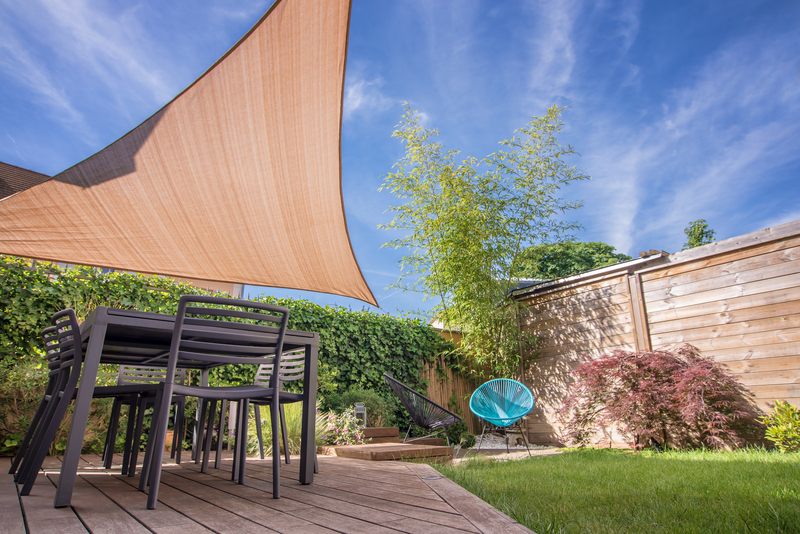Innovative Wind Solutions for Gardens: Keep Your Plants Safe
Posted on 07/06/2025
Innovative Wind Solutions for Gardens: Keep Your Plants Safe
Wind can be both a garden's friend and foe. While gentle breezes aerate plants and help with pollination, strong gusts and continuous winds can wreak havoc, damaging delicate stems, uprooting young plants, desiccating leaves, and breaking branches. If you live in a windy area or face occasional storms, fortifying your garden becomes essential. In this comprehensive guide, we delve into innovative wind solutions for gardens to keep your flora resilient, vibrant, and safe. Discover a mix of traditional wisdom and cutting-edge ideas to shield your cherished green space from the harshest gusts.

Understanding Wind's Impact on Garden Plants
Before delving into innovative solutions, it's crucial to grasp how wind affects your garden. Here are several ways wind can challenge gardeners:
- Physical Damage: Snapped branches, toppled plants, and uprooted seedlings.
- Desiccation: Wind accelerates moisture loss from soil and leaves, leading to wilting.
- Pollination Interference: Excessive wind can disturb delicate pollination processes.
- Soil Erosion: Gusts blow topsoil away, depleting nutrients and exposing roots.
- Temperature Fluctuations: Cold winds can chill sensitive plants, while hot winds dry them out.
Identifying these hazards is the first step towards developing tailored, innovative wind solutions for gardens.
Natural Windbreaks: Harnessing Nature for Protection
One of the oldest, yet most effective strategies is establishing windbreaks using plants themselves. A living windbreak enhances biodiversity and fits seamlessly into any garden design. Here are some garden wind protection ideas with natural materials:
1. Planting Hedgerows
- Diverse species: Mix deciduous and evergreen shrubs or trees for year-round protection.
- Placement: Position windbreaks perpendicular to prevailing wind directions.
- Strategic gaps: Allow small gaps (10-20%) to diffuse wind rather than create turbulence.
- Layering: Stagger rows with tall trees at the center and shorter shrubs on the edges.
Popular choices for living windbreaks include privet, junipers, arborvitae, and faster-growing options like willows or bamboo for instant protection.
2. Shelterbelts
Shelterbelts are broader, multi-row plantings usually placed along property boundaries. In gardens, a compact version can shield entire beds. Incorporate native grasses as ground cover to stabilize soil and provide extra defense against erosive winds.
3. Climbing Plants and Trellises
- Vines such as clematis, honeysuckle, or ivy can be trained along fences or trellises to add another layer of wind resistance.
- For edible gardens, consider hardy climbing beans or peas as functional wind barriers.
Modern & Creative Garden Wind Barriers
While traditional methods work wonders, sometimes your garden demands cutting-edge solutions. Here are some of the most popular and innovative wind solutions for gardens available today:
1. Permeable Garden Screens
Forget the old solid fence! Wind-permeable screens are specifically designed to slow and diffuse wind, minimizing vortex effects on the leeward side. Consider these modern wind protection for gardens materials:
- Woven willow panels: Rustic, natural look with small gaps for wind to pass through gently.
- Mesh poly screens: Durable, UV-resistant options; easy installation on netting supports or fencing.
- Laser-cut metal panels: Both decorative and functional, these offer a contemporary touch.
- Reed or bamboo fencing: Lightweight and eco-friendly, perfect for temporary or movable barriers.
2. Retractable & Modular Wind Barriers
Adaptability is key in innovative garden wind solutions. Modular and retractable screens can be moved or adjusted based on the season, storm alerts, or plant rotations. Try:
- Telescoping windbreaks: Aluminium or plastic units that extend as needed.
- Mobile garden walls: Mounted on wheels for easy repositioning, protecting young or vulnerable plants as they grow.
- Pop-up greenhouse tents: Instant weather shields that zip over raised beds or containers for temporary protection.
These temporary solutions are perfect for renters or experimental gardeners seeking flexibility.
3. Garden Wind Sails
Inspired by nautical science, wind sails can be strung up in your garden to deflect prevailing gusts. Made of durable canvas, polyester, or specialized mesh, these sails:
- Provide shade and wind diversion in one elegant solution.
- Come in eye-catching colors and geometric patterns to decorate your outdoor space.
Design Considerations for Wind-Resilient Gardens
To maximize the effectiveness of wind solutions in gardens, consider these essential design strategies:
1. Analyze Your Garden Layout
- Identify wind directions: Observe and map predominant wind sources throughout the year.
- Locate vulnerable spots: Pay attention to gaps in fencing, open areas, or raised beds at higher elevations.
- Layer barriers: Use multiple lines of defense, combining natural and artificial structures for best results.
2. Integrate Multi-Purpose Elements
- Fences can double as trellis supports for climbing vegetables or flowers.
- Living windbreaks provide habitat for pollinators and birds, boosting overall ecosystem health.
- Rainwater harvesting: Direct runoff from impervious wind barriers into collection systems for sustainable irrigation.
3. Scale Up or Down
Whether you are shielding an urban balcony garden or a sprawling backyard, size your wind solutions accordingly. Mini barriers for planter pots can be made from craft mesh or plexiglass panels, while large gardens may need substantial multi-row shelterbelts.
Best Plants for Windy Gardens
Some plants naturally stand up to wind better than others. Planting wind-resistant species is a smart way to add resilience to your green space. Here are some top picks for wind-proof garden plants:
- Grasses: Feather Reed Grass (Calamagrostis), Fountain Grass (Pennisetum), Switchgrass (Panicum virgatum). Flexible stems sway without breaking.
- Shrubs: Boxwood, Spirea, Barberry, or Viburnum. Dense forms withstand gusts.
- Trees: Serviceberry, Hawthorn, Elm, Maritime Pine. Deep roots and strong trunks offer stability.
- Groundcovers: Creeping Thyme, Lamb's Ear, Ajuga. Provide soil armor against erosion and dehydration.
- Succulents: Sedum, Sempervivum ("hens and chicks"), Agave. Tolerate moisture loss and exposure.
For exposed environments, always prioritize plants with flexible stems, small or leathery leaves, and deep roots.
Maintenance Tips: Keeping Wind Solutions Effective
Even the best garden wind solutions require regular upkeep. Protect your investment and your plants with these maintenance tips:
- Inspect barriers: Look for wear, rot, loose posts, or tears in fabric screens after each season.
- Prune living windbreaks: Maintain shape and density by trimming shrubs and trees annually.
- Mulch generously: Apply organic mulch around plant bases to reduce soil erosion and conserve moisture.
- Stake young plants: Use flexible ties so stems don't snap in gusts as they mature.
- Monitor soil moisture: Wind dries both surface and deeper layers rapidly--adjust your watering schedule as needed.
Extreme Wind Events: Emergency Garden Protection
Sometimes, storms arrive suddenly and local winds far outpace normal conditions. Equip your garden for emergency windproofing with these tips:
- Collapsible row covers: Easily deployed over vegetable beds or flower rows before a windstorm.
- Heavy-duty plant anchors: Use landscape pins for lightweight containers or anchor hoop tunnels with sandbags.
- Temporary netting: Drape bird netting over sensitive bushes or young fruit trees for a quick wind buffer.
Have emergency supplies on hand during storm-prone seasons to minimize plant damage and speed recovery.
DIY Ideas for Affordable Garden Wind Solutions
Protecting your garden from wind doesn't have to break the bank. Here are some DIY innovative wind solutions you can make quickly and inexpensively:
- Recycled pallet fencing: Stand old pallets upright and stake them into the ground for a rustic, wind-breaking wall.
- Plastic bottle wind wall: Cut the bottom off 2-liter bottles, stack, and secure on garden stakes for a see-through, wind-diffusing barrier.
- Burlap screens: Stretch burlap between bamboo poles for a light, biodegradable barrier around young plants.
- Upcycled window frames: Attach old window frames in a zig-zag pattern for windbreaks with vintage flair.
- Potted plant buffers: Use large containers of hardy shrubs as portable wind shields on patios or decks.
These solutions are perfect for those wanting to try innovative wind protection without making permanent changes.

The Benefits of Prioritizing Wind Solutions for Your Garden
Incorporating innovative wind solutions for garden safety yields a host of benefits, including:
- Healthier plants: Reduced stress and physical damage mean lusher, more productive growth.
- Soil preservation: Prevents erosion and nutrient loss, ensuring a sustainable foundation.
- Water efficiency: Minimizes moisture loss, lowering irrigation needs and costs.
- Increased yields: Fruits and vegetables thrive when shielded from drying or battering winds.
- Aesthetic appeal: Thoughtfully placed windbreaks or screens can create beautiful garden "rooms" and microclimates.
- Wildlife habitat: Living barriers host pollinators, songbirds, and beneficial insects.
Conclusion: Embrace Innovation and Keep Your Plants Safe
No matter where you garden--from windswept city balconies to breezy rural backyards--addressing wind protection for gardens is vital. By blending traditional natural barriers with innovative wind solutions like permeable screens, modular fences, and creative DIY shields, you can ensure lush, healthy plants year-round. Observe your microclimate, experiment with layered defenses, and select wind-resistant plants for a thriving, resilient green space.
For gardeners ready to take action, start by assessing your wind exposure, choosing the right combination of barriers, and maintaining them regularly. With these strategies in place, you'll enjoy a beautiful, bountiful, and wind-safe garden for many seasons to come.
Related searches:
- Best windbreak plants for gardens
- Wind resistant fencing ideas
- How to protect vegetables from wind
- DIY wind barriers for garden
- How does wind affect garden plants?
Start implementing these innovative wind solutions for your garden today--your plants (and harvest) will thank you!

